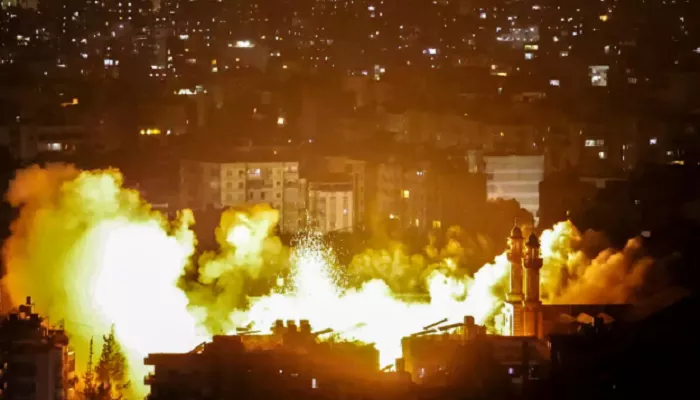A series of Israeli airstrikes struck southern suburbs of Beirut late Thursday night, targeting what the Israeli military said were underground Hezbollah drone manufacturing facilities. The strikes triggered widespread panic, traffic chaos, and drew sharp condemnation from Lebanese leaders.
Thick smoke rose over the Lebanese capital as residents fled the area, fearing further attacks. Lebanon’s state-run ANI news agency reported nearly a dozen strikes, including two that were described as “very violent.” AFP journalists also reported hearing at least two large explosions.
In a statement released on Telegram, the Israel Defense Forces (IDF) confirmed the strikes, saying they were hitting “terror targets of the Hezbollah aerial unit.” Just two hours before the airstrikes, IDF Arabic-language spokesperson Avichay Adraee had warned residents on social media to evacuate, stating that Hezbollah facilities were operating in civilian areas.
Another IDF statement said the military was targeting “underground UAV (drone) production infrastructure sites that were deliberately established in the heart of the civilian population” in Beirut.
The United Nations Special Coordinator for Lebanon condemned the airstrikes, stating on social media that they had “generated renewed panic and fear.” The coordinator urged all parties to avoid actions that could lead to further escalation, emphasizing that diplomatic channels remain available for resolving conflicts.
Lebanon’s President Joseph Aoun issued a statement condemning the Israeli strikes as a “flagrant violation” of the ceasefire reached on November 27, which he said was breached on the eve of the Muslim holiday Eid al-Adha. Aoun called the attack proof of Israel’s rejection of a just peace in the region.
Prime Minister Nawaf Salam also denounced the strikes, calling them a “blatant violation of Lebanese sovereignty” and of the 2006 United Nations resolution that helped end a previous war between Hezbollah and Israel.
The strikes come amid continued tensions between Israel and Hezbollah. The two sides have been engaged in more than a year of hostilities that escalated with the war in Gaza and included an Israeli ground incursion into southern Lebanon.
The November ceasefire was meant to halt the violence, with terms requiring Hezbollah to withdraw its fighters north of the Litani River and dismantle military sites in southern Lebanon. Israel, in turn, was to withdraw troops from Lebanese territory, though it has retained five strategic positions near the border.
While Israeli strikes have frequently targeted southern Lebanon, attacks on Beirut’s southern suburbs—seen as Hezbollah strongholds—are rare.
According to the IDF, Hezbollah has been stepping up drone production for future conflicts, in what it called a “blatant violation” of ceasefire understandings. The Israeli military said Hezbollah has used UAVs extensively in past attacks and is preparing to expand this capability.
In response, Lebanese Prime Minister Salam reported that the army has already dismantled over 500 Hezbollah military positions and weapons depots in the south, reinforcing Lebanon’s commitment to the ceasefire agreement.


